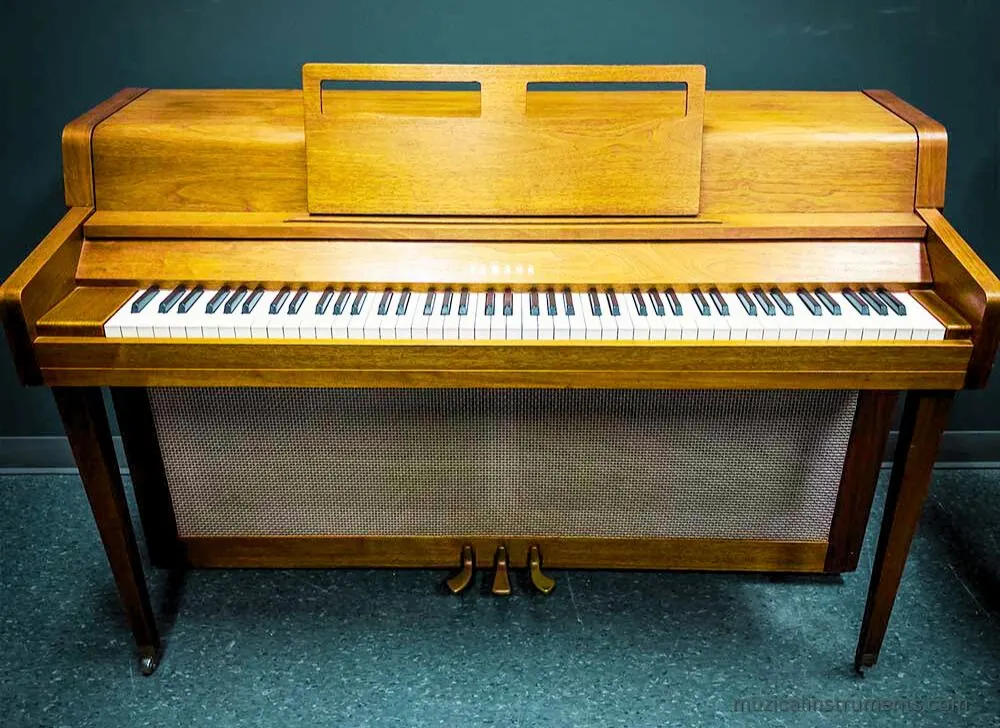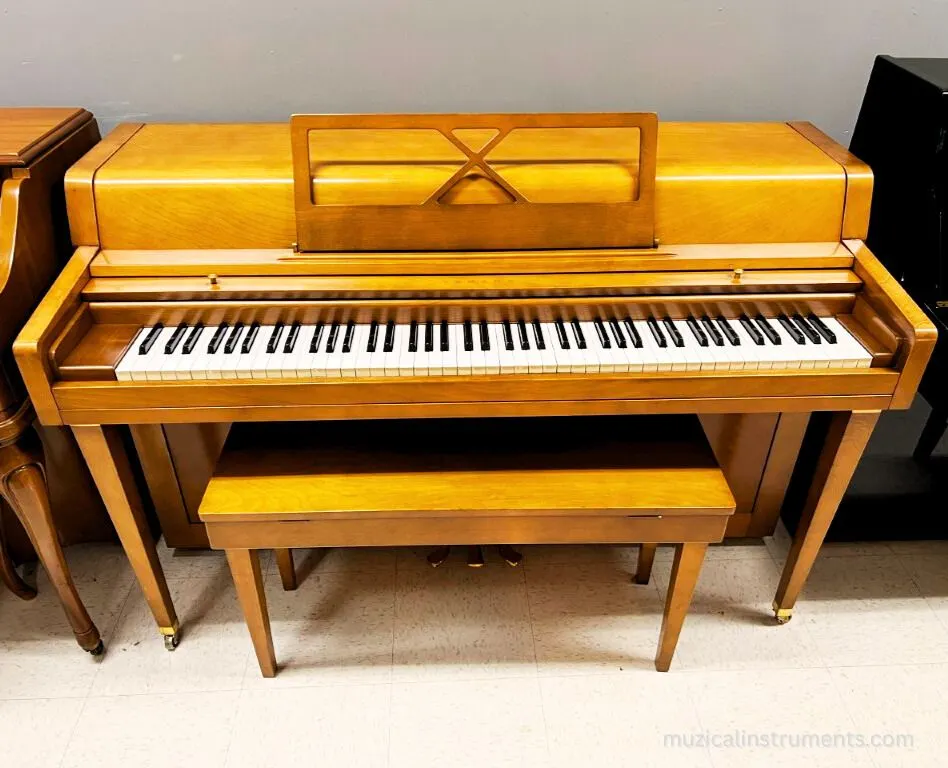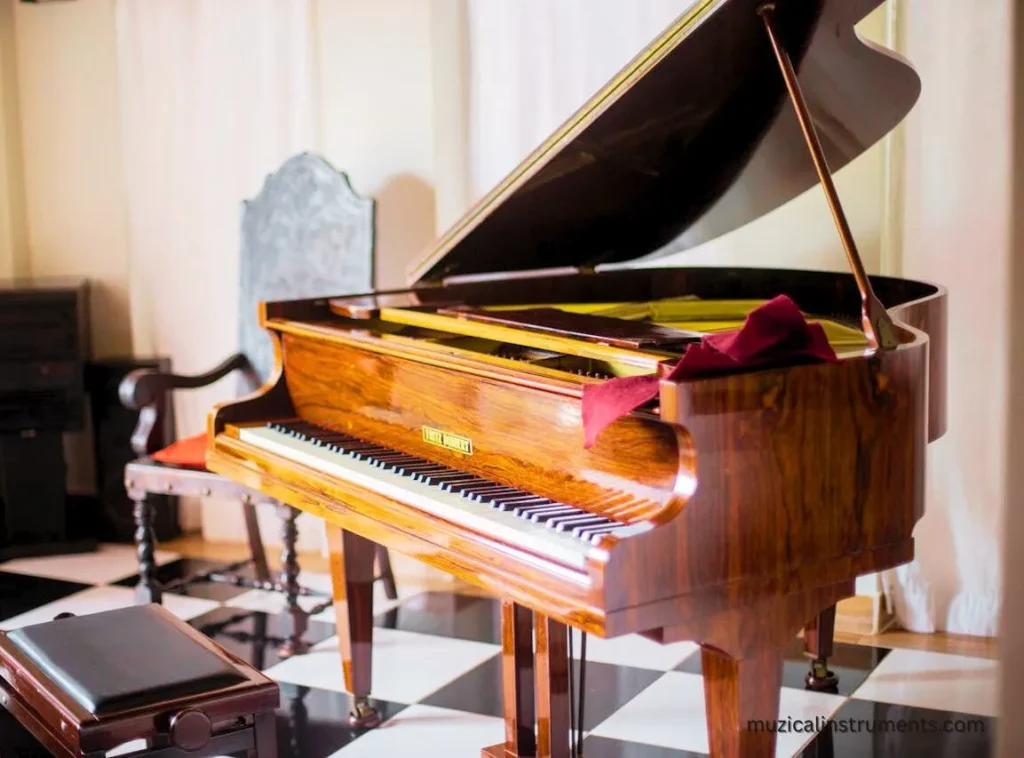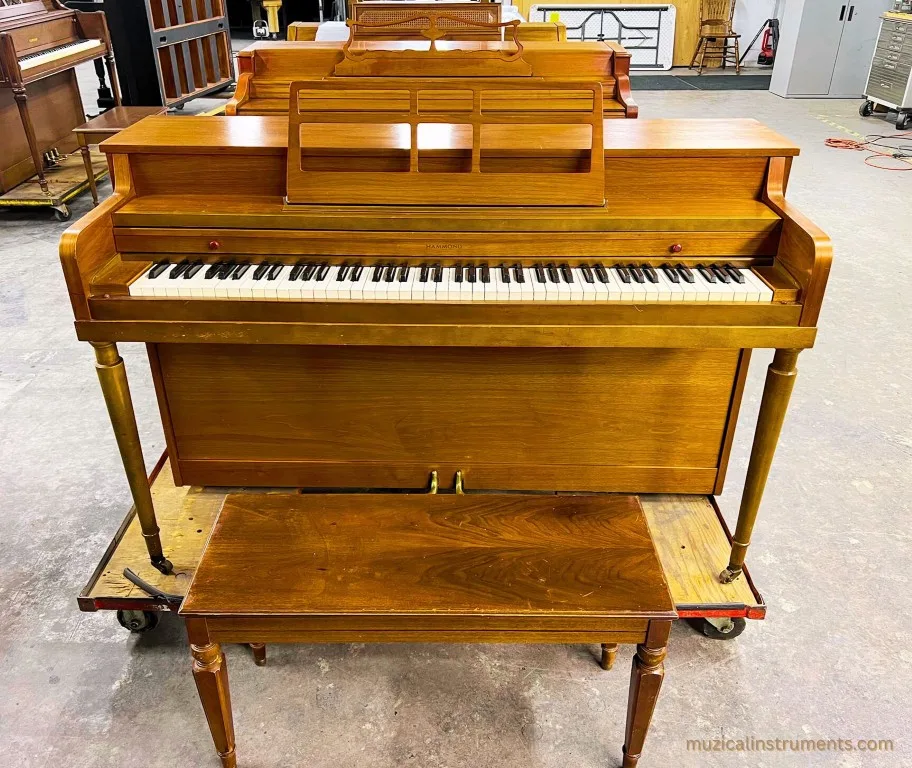Spinet Pianos: Are They Real Pianos or Just Lookalikes?

Are spinet pianos real pianos? Yes, they are. But they’re not like the big ones you see on stage or in music schools.
A spinet piano is the smallest upright piano, only 36 to 40 inches tall. It’s still an acoustic instrument, not digital. It has keys, strings, and hammers. You press a key, a hammer hits a string, and sound comes out. That’s what makes it a real piano.
But the inside is different. It uses a drop action, a special part that moves the hammer in a tight space. This makes it harder to fix, and not as fast to play. The strings are shorter, and the soundboard is smaller, so the sound is soft, not rich like a tall upright or grand.
Spinets were common in homes from the 1930s to the 1990s. People liked them because they were cheap and fit in small rooms. Today, they’re no longer made, but you can still find them second-hand.
So yes, it’s a real piano. Let’s find out what it is, and how it is different from main pianos.
What Is a Spinet Piano?
A spinet piano is the smallest type of upright piano. It stands only about 36 to 40 inches tall. That’s about the height of a kitchen counter.
It looks like a normal upright, but it’s built smaller. Everything inside is packed tight. It still has 88 keys, just like a big piano, but the strings and soundboard are shorter and smaller.
Inside, it uses something called a drop action. This is a special part that lets the hammer move from a lower spot. It was made this way to save space. But it also makes the piano harder to repair and less fun to play for some people.

Spinets were very popular from the 1930s to the 1990s. Families loved them because they were cheap, compact, and easy to move. You’ll still find them in older homes and second-hand stores today.
So, what is a spinet? It’s a real acoustic piano, just a very small one, made to fit where bigger pianos can’t go.
What Makes a Spinet Piano Different?
Spinet pianos may look like a smaller upright, but inside, it’s very different.
The biggest difference is the drop action. In most upright pianos, the hammers and keys are in a straight line. Press a key, and the hammer moves right away. In a spinet, the parts are stacked. The hammer sits lower, so it needs an extra lever to work. That’s the drop action.
This makes the piano more complicated inside. It’s harder to fix and doesn’t feel as smooth when you play. That’s why many piano tuners and teachers don’t recommend it for serious practice.
Also, the strings are shorter, and the soundboard is smaller. This makes the sound less powerful. It’s quieter, with less depth. Good for light play, but not for strong music or big rooms.


In short:
- Drop action = harder to fix
- Short strings = weaker sound
- Small soundboard = less tone
- Cramped inside = tough for repairs
These things don’t mean it’s bad. But they do make it different, and not the best pick if you want to grow your skills over time.
How Does a Spinet Piano Sound?
A spinet piano has a soft, light sound. It’s not loud. It’s not rich. The tone is clear but simple.
That’s because the strings are shorter and the soundboard is smaller than in larger upright pianos. Those parts help shape the piano’s sound. With less space, you get less volume and less depth.
If you just want to play simple songs or need a piano for quiet practice, the sound might be okay. But if you want a full, warm tone, like what you hear from a console or studio upright, a spinet won’t give you that.
Also, because of the drop action, it feels a bit stiff. The keys don’t respond as quickly as they do on better upright pianos. This can make it harder to play fast or soft passages with control.
In short:
- Tone = soft, light, not bold
- Volume = low
- Key feel = slower, harder touch
- Best for = quiet play, basic use
So yes, it sounds like a real piano. But don’t expect it to fill a room or impress a trained ear.
Spinet vs Console vs Upright: What’s the Real Difference?
You’ve seen the words: spinet, console, upright. They all look like vertical pianos. So what’s the difference?
Let’s break it down in the easiest way:
| Feature | Spinet | Console | Full Upright |
|---|---|---|---|
| Height | 36–40 inches | 40–44 inches | 45+ inches |
| Action Type | Drop action (indirect) | Direct action (better) | Direct action (best) |
| Sound | Soft, thin | Clear, fuller | Deep, strong |
| Touch | Slower, stiff | Smoother | Best feel |
| Best For | Small space, light use | Beginners, homes | Learners, practice |
A spinet is the smallest and cheapest. It’s good if you don’t have much space. But the drop action makes it harder to fix and slower to play.
A console piano is a bit taller. It has better parts and a direct action. That means the keys and hammers move together more smoothly. It sounds better and feels better to play.
A full upright is the biggest of the three. It has longer strings and a larger soundboard, so it gives you a strong, rich sound, close to a grand piano. Great if you’re serious about learning or teaching.
So if you’re choosing:
- Go with a spinet if space is tight and you just want to play.
- Pick a console if you’re starting lessons and want a better feel.
- Choose a full upright if you care about sound, touch, and growth.
Should You Buy a Spinet Piano?
Now you know the facts. So, should you buy a spinet piano?
It depends on what you need.
| Good Reasons to Say Yes | Reasons to Be Careful |
|---|---|
| You don’t have much space | You want to learn piano seriously |
| You want a real piano, not a keyboard | You need good sound and fast keys |
| You found one for free or very cheap | You plan to play for many years |
| You just want to play simple songs | You don’t want to deal with hard repairs |
What Happened to Spinet Pianos?
Spinet pianos aren’t made anymore. They stopped showing up in factories around the 1990s.

Why? Because people wanted better sound and better touch. As homes got bigger and digital pianos got cheaper, the need for spinets faded.
Console pianos became more popular. They had stronger sound, smoother keys, and weren’t much taller. For a small price jump, you got a big upgrade.
Also, piano techs didn’t like working on spinets. The drop action was cramped and tricky. Repairs took longer and cost more. Over time, many families just gave them away or moved on.
Today, you’ll find spinets in second-hand ads, basements, or schools that haven’t updated in years. Some still work fine. But most are old, worn, or need tuning.
They had their time, but that time has passed.
FAQ
1. Is a spinet piano suitable for beginners?
A spinet piano can be a starting point due to its affordability and compact size. However, its unique “drop action” mechanism may offer a different touch and responsiveness compared to larger pianos, potentially affecting the learning experience for beginners.
2. What is the “drop action” in a spinet piano?
The “drop action” refers to the indirect mechanism where keys connect to the hammers via rods, allowing for a more compact design. This setup, while space-saving, can make maintenance more challenging and may impact the piano’s touch sensitivity.
3. How does a spinet piano’s sound compare to other pianos?
Spinet pianos typically produce a softer, less resonant sound due to their shorter strings and smaller soundboards. This makes them suitable for small spaces but may not provide the rich tones found in larger upright or grand pianos.
4. Are spinet pianos still manufactured today?
No, spinet pianos are no longer in production. They were most popular from the 1930s to the 1990s. Today, they are primarily available through second hand markets.
5. What should I consider when buying a used spinet piano?
When considering a used spinet piano:
Condition: Check for any signs of wear or damage.
Brand: Some brands, like Baldwin Acrosonic, are known for better quality.
Maintenance History: Ensure the piano has been regularly maintained.
Professional Inspection: Have a piano technician assess the instrument before purchase.
6. How does a spinet piano differ from a console or upright piano?
While all are vertical pianos, spinets are the smallest, featuring the drop action mechanism. Consoles are slightly taller with direct action, offering better touch and sound quality. Upright pianos are the largest, providing the richest sound and most responsive touch.
Final Verdict: Is a Spinet Piano Right for You?
Yes, a spinet piano is a real piano. It has strings, hammers, and a soundboard. It can play music. But it’s not for everyone.
If you just want a small, cheap piano for basic play, a spinet might work. It’s good for tight spaces and quiet homes. But if you care about sound, touch, and long-term use, it’s better to skip it.
Here’s what to remember:
- Drop action = slower keys, harder repairs
- Short strings = smaller sound
- Old parts = more maintenance
For real growth, choose a console piano or upright piano. They sound better, feel better, and last longer.
So think about your goals. If you’re starting out, want to enjoy music, and found a working spinet for cheap, it can be a fine place to begin. Just know its limits.
If you’re not ready for a spinet piano, you can check out our guide on how to choose the right piano keyboard for your needs.

[…] for smaller acoustic options? Learn what a spinet piano is and why it’s perfect for tight […]